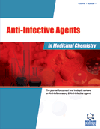- Home
- A-Z Publications
- Anti-Infective Agents in Medicinal Chemistry (Formerly Current Medicinal Chemistry - Anti-Infective Agents)
- Previous Issues
- Volume 5, Issue 2, 2006
Anti-Infective Agents in Medicinal Chemistry (Formerly Current Medicinal Chemistry - Anti-Infective Agents) - Volume 5, Issue 2, 2006
Volume 5, Issue 2, 2006
-
-
Current Status of Target-Based Antimycobacterial Natural Products
More LessAuthors: Sanjay M. Jachak and Rahul JainThe situation of tuberculosis disease has recently been complicated by the human immunodeficiency virus epidemic and the increased prevalence of multi-drug resistant strains of Mycobacterium tuberculosis. The new drugs which are affordable and more effective compared to clinically used, are required to target resistant strains of M. tuberculosis and emerging pathogens, such as M. avium complex. Most of the reported nat Read More
-
-
-
Medicinal Chemistry of Ureido Derivatives as Anti-Infectives
More LessAuthors: Sanjay Batra, Zehra Tusi and Sudharshan MadapaUreides are compounds, which essentially incorporate urea as a substructural component either in open or cyclic form. Ureido derivatives are one of the oldest classes of bioactive compounds, widely used as anti-infective agents. Several of these compounds, including aminoquinuride, aminocarbalide, imidurea, cloflucarban, nitrofurazone, urosulfan, are viomycin are used in clinical situations. One of the ureides, the tric Read More
-
-
-
The Bananins: New Anticorona-RNA-Viral Agents with Unique Structural Signature
More LessThe purpose of this contribution is to introduce the bananins or trioxa-adamantane-triols (TATs), a newly discovered class of anti-RNA-coronaviral agents which are active against human severe acute respiratory syndrome (SARS) coronavirus (SARS-CoV). The prototype compound bananin inhibited replication of SARS-CoV, probably through inhibition of SARS-CoV nsp13 ATPase/NTPase DNA/RNA helicase protein enzymatic fu Read More
-
-
-
Advances in Chagas Disease Chemotherapy
More LessAuthors: P. M.M. Guedes, J. L.R. Fietto, M. Lana and M. T. BahiaChagas disease is endemic from Mexico to Argentina, where it is estimated that 16 to 18 million people are infected with its causative agent, Trypanosoma cruzi, and 100 million remain at risk of infection, emphasizing the necessity to sustain and extend control measures and strategies to combat this disease. Specific chemotherapy with benznidazole or nifurtimox has been recommended for treatment of recent and conge Read More
-
-
-
Pharmacologically Active Sulfur-Containing Compounds
More LessAuthors: Tomas Rezanka, Miroslav Sobotka, Jaroslav Spizek and Karel SiglerIn addition to sulfur-containing compounds that form essential and indispensable constituents of all living cells, there is a plethora of less wide-spread sulfur-containing compounds with much less common and often unexpected properties, chemical structures and biological activities. Some of these compounds have long been known as efficient antibiotics. This review surveys these less known compounds with two and more Read More
-
Most Read This Month
Article
content/journals/aiamc
Journal
10
5
false
en


